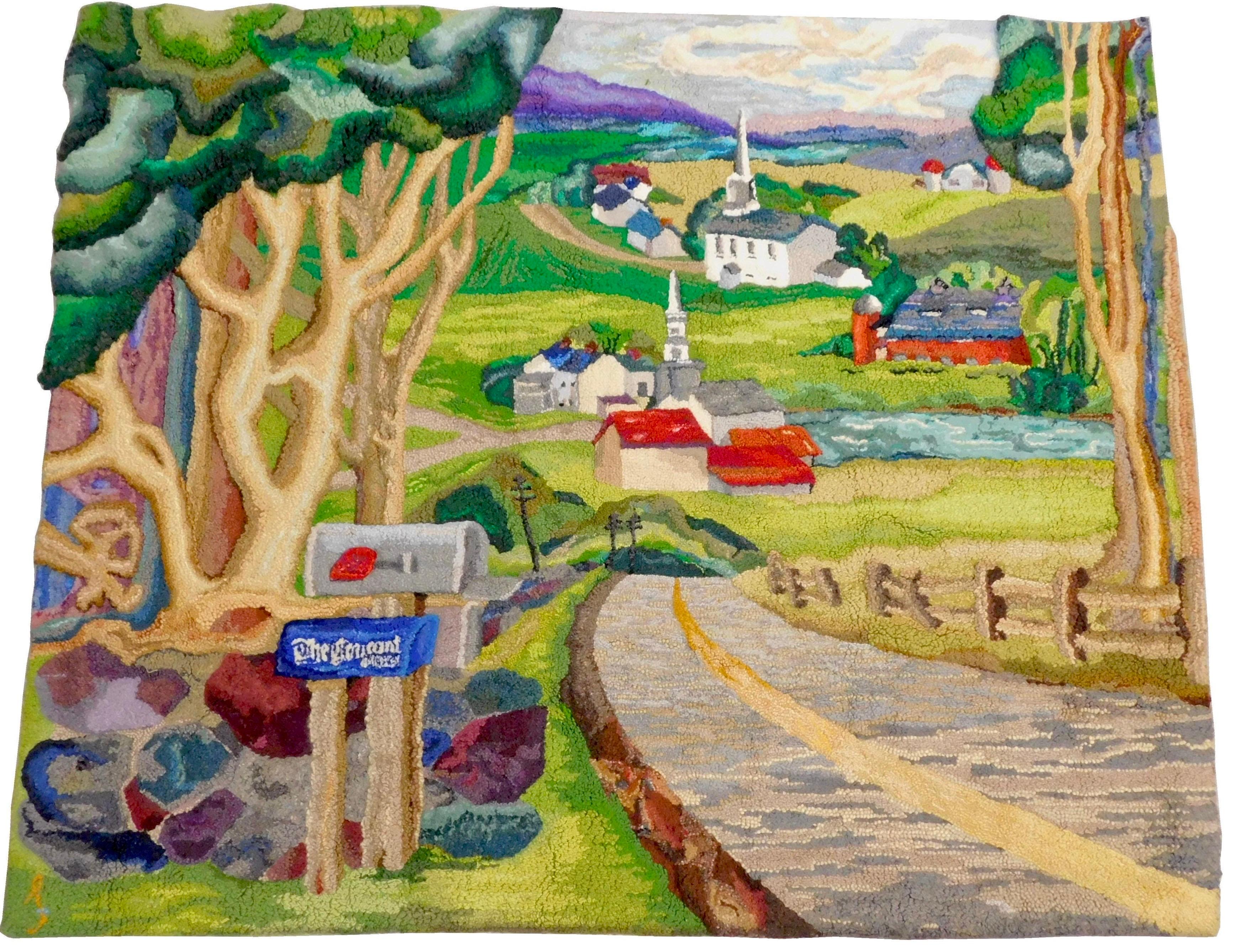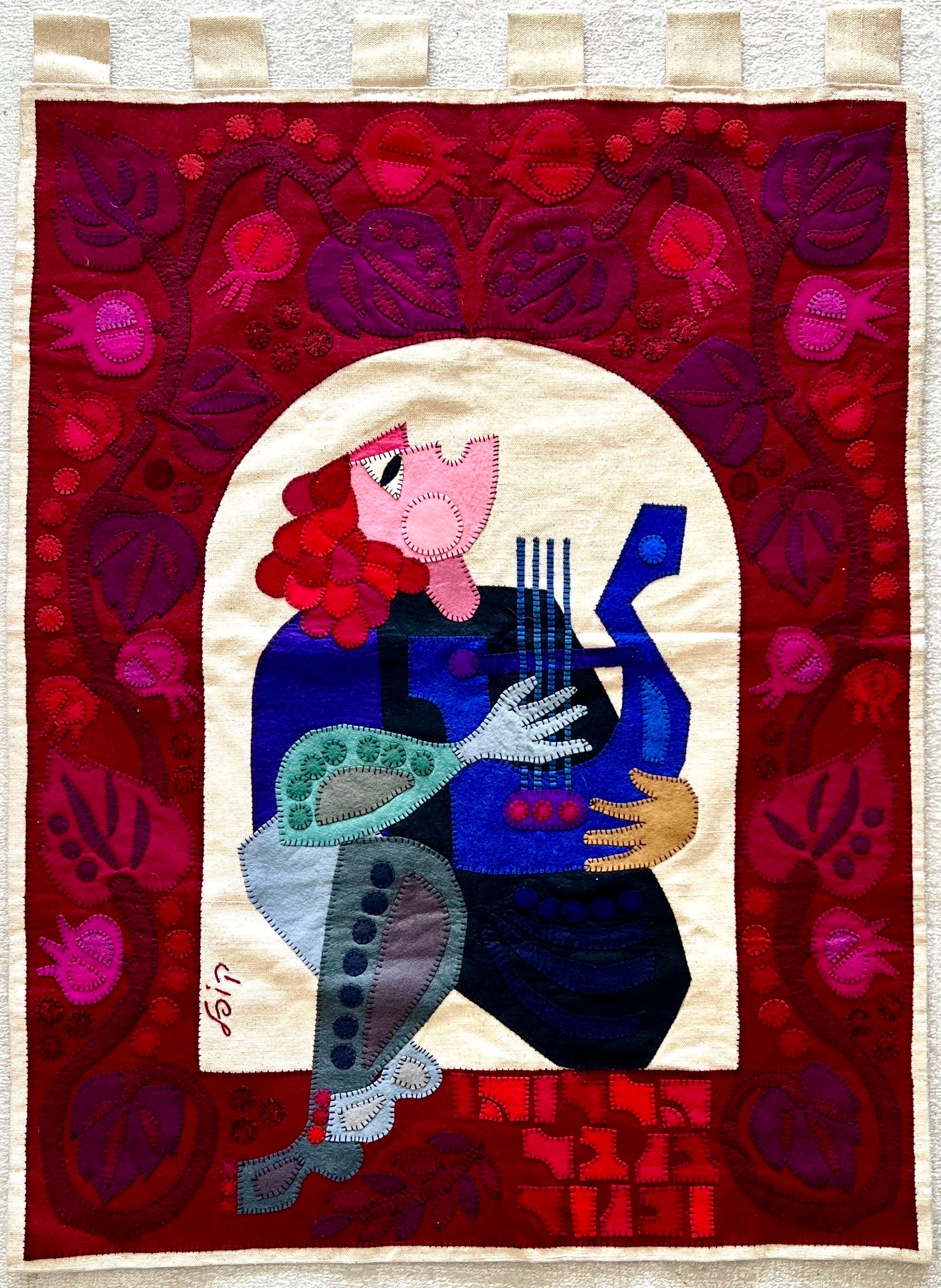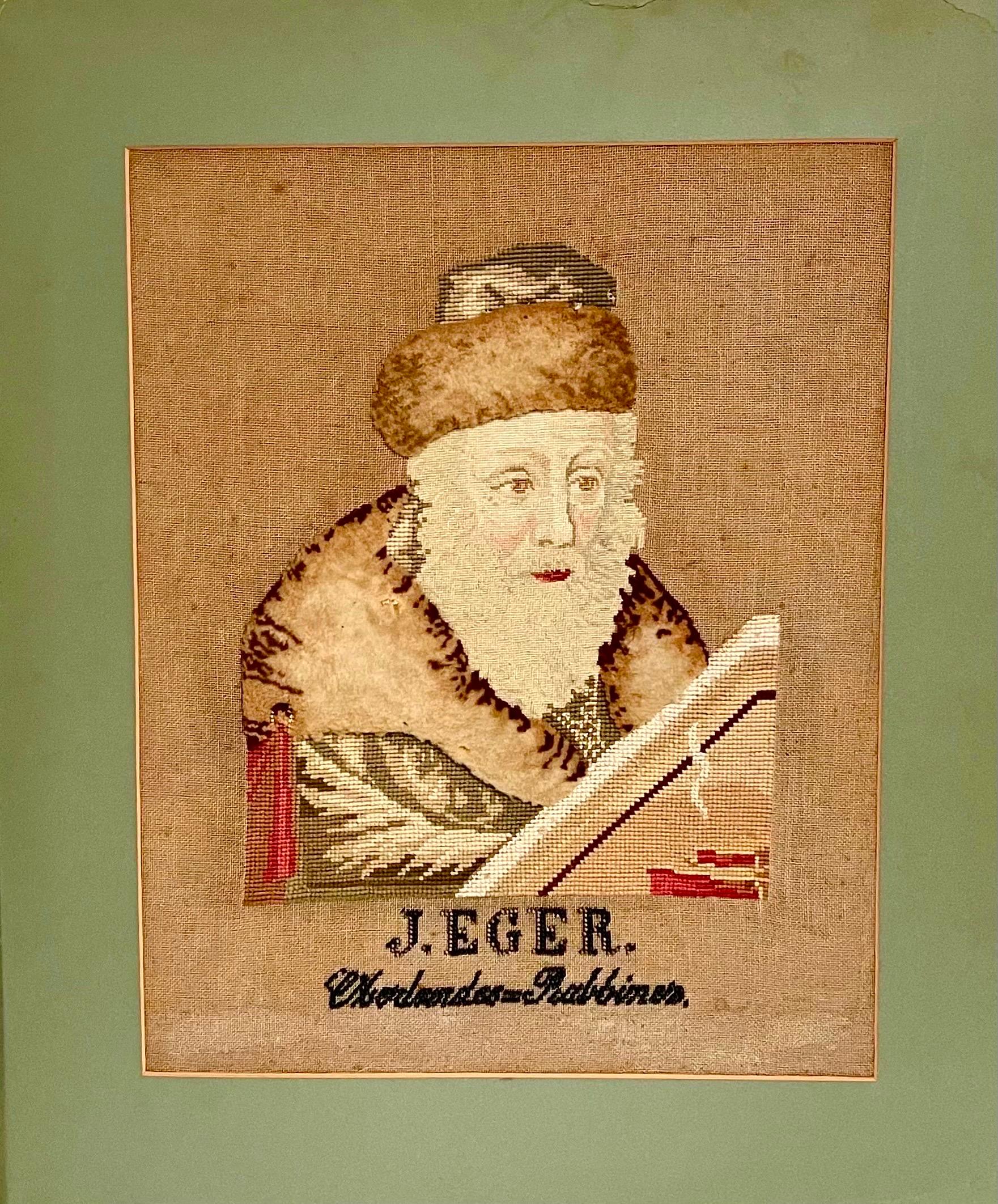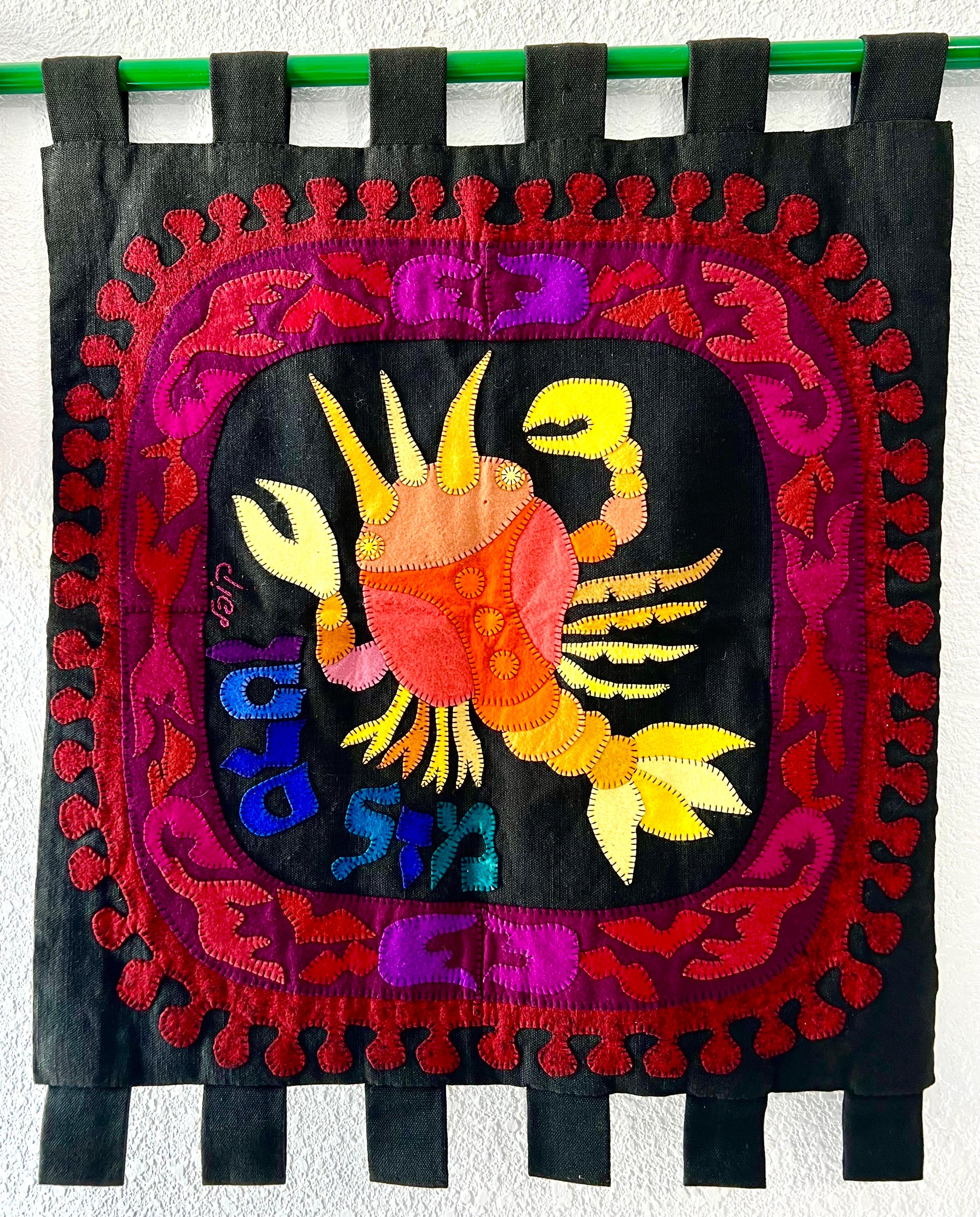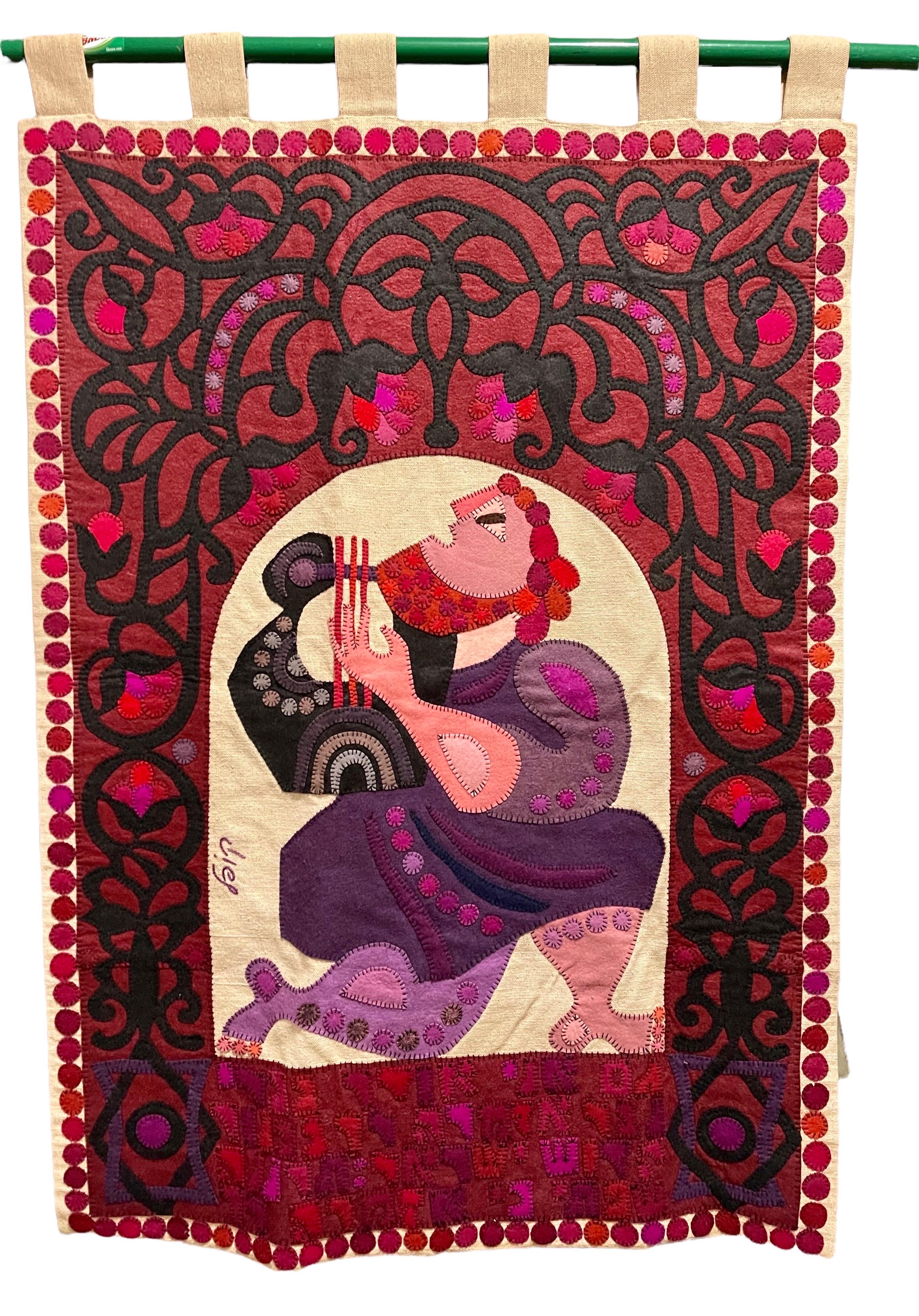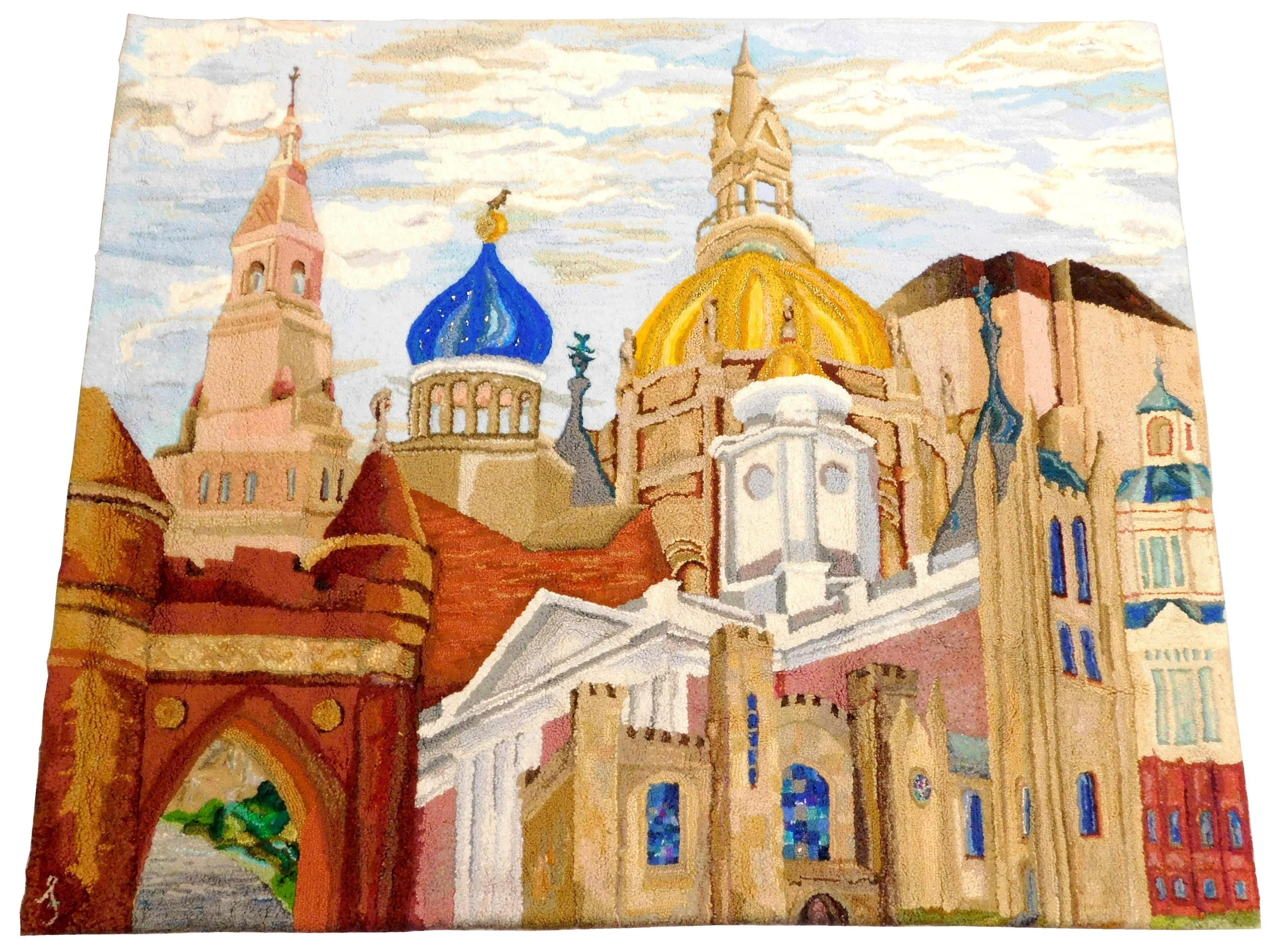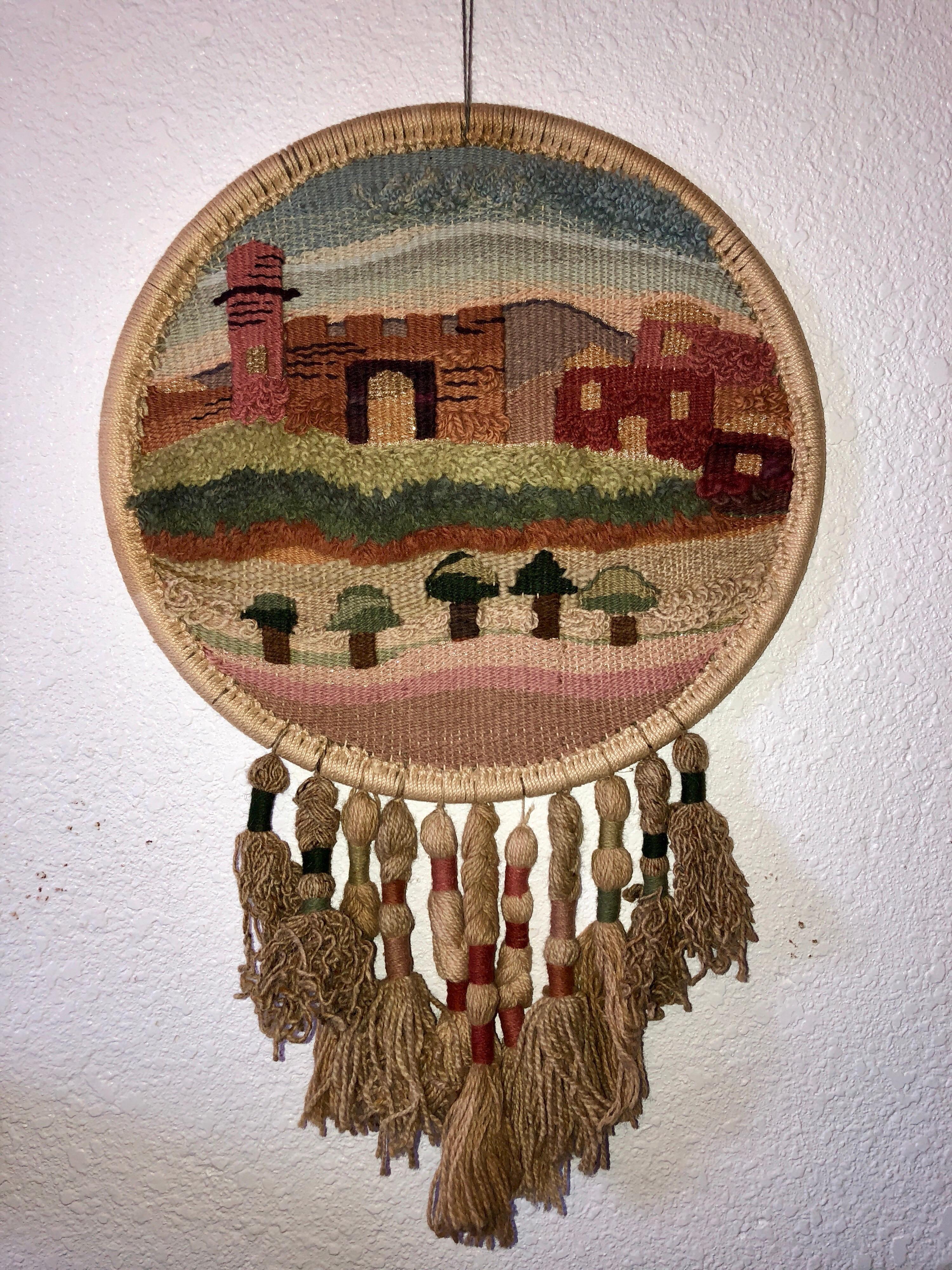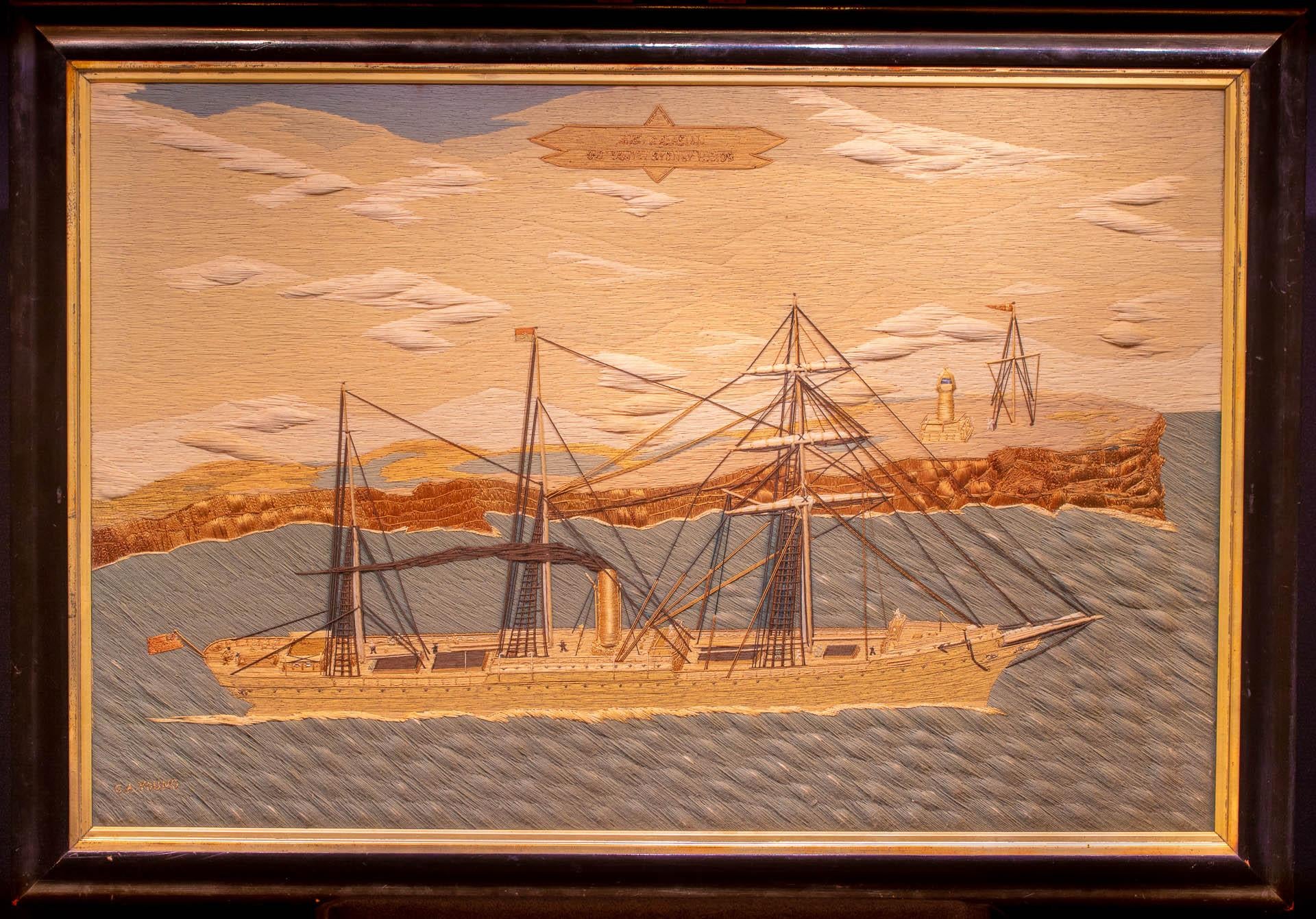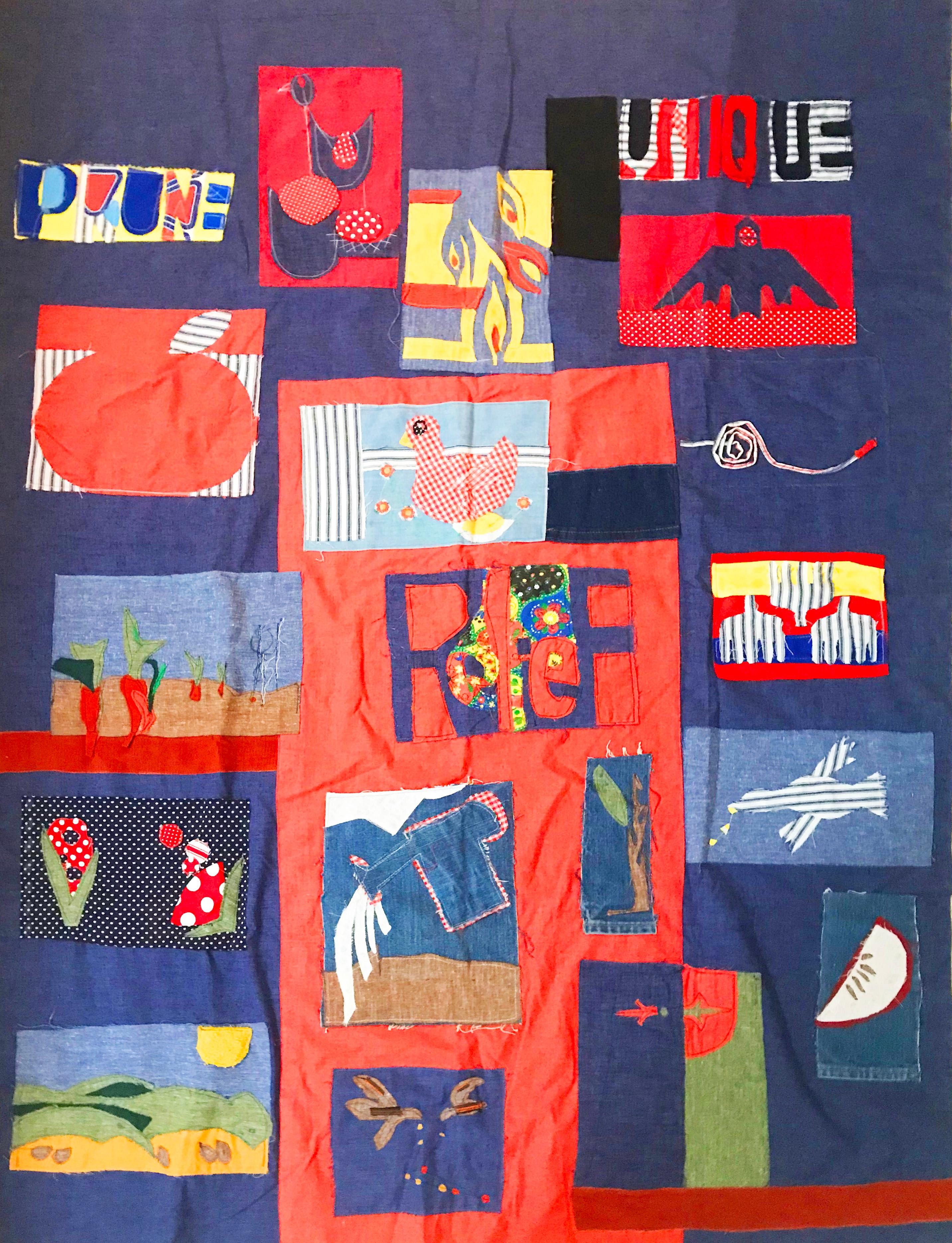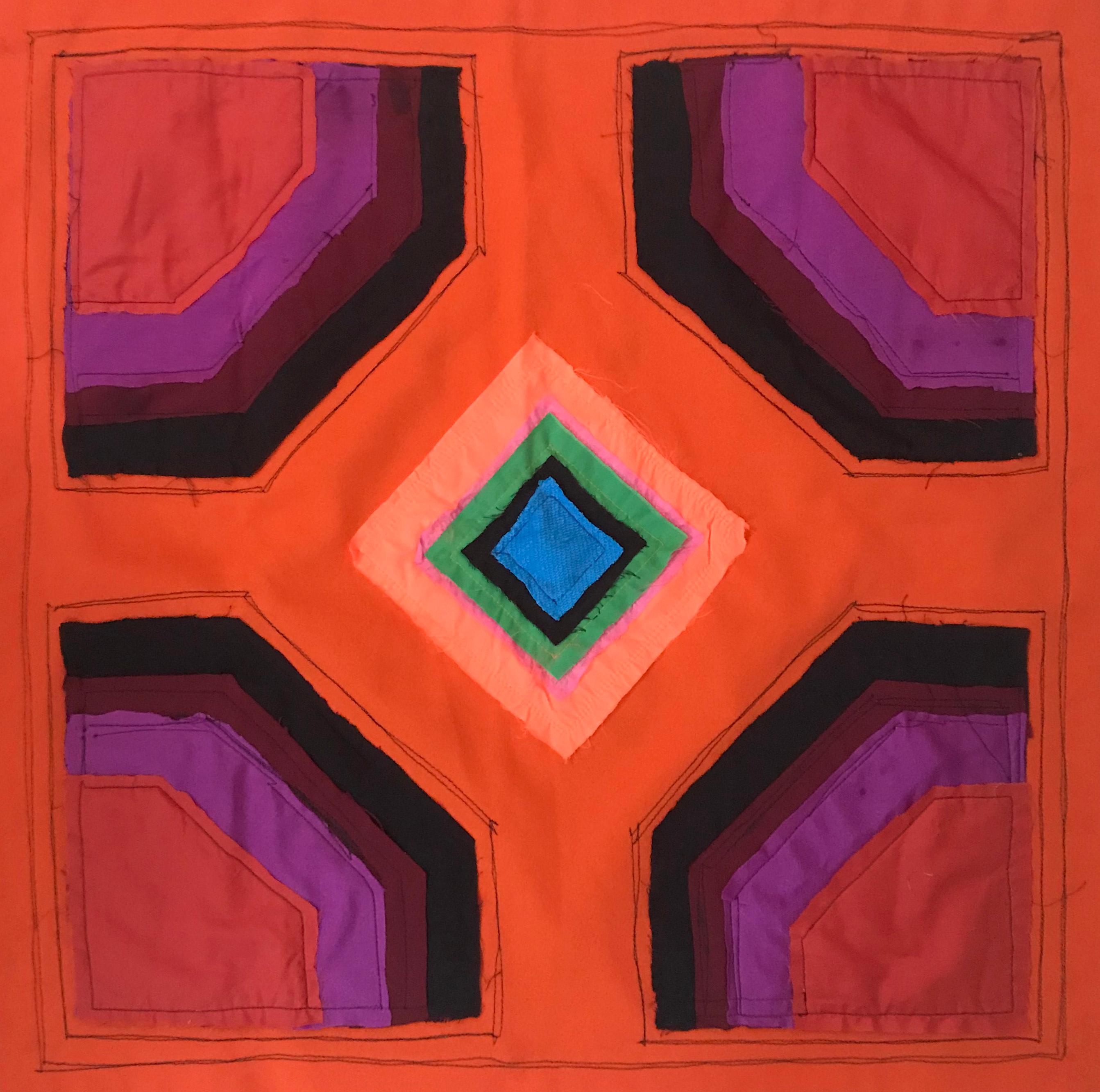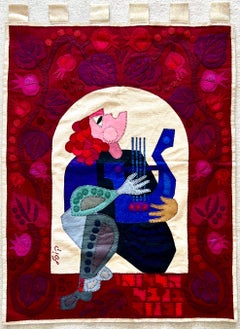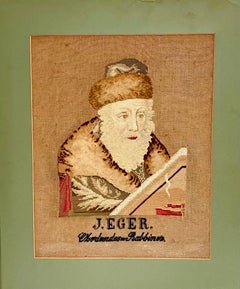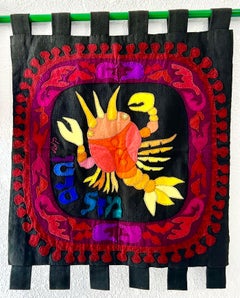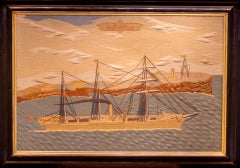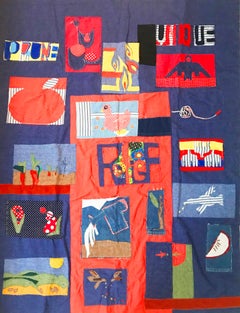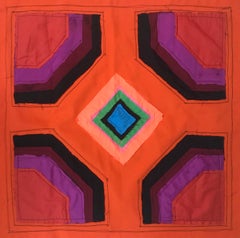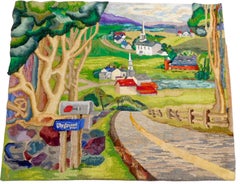
Large Americana Folk Art Pictorial Hooked Rug Wool Wall Hanging Tapestry
Want more images or videos?
Request additional images or videos from the seller
1 of 10
Trudi ShippenbergLarge Americana Folk Art Pictorial Hooked Rug Wool Wall Hanging Tapestry
About the Item
- Creator:Trudi Shippenberg (American)
- Dimensions:Height: 72 in (182.88 cm)Width: 84 in (213.36 cm)
- Medium:
- Movement & Style:
- Period:
- Condition:minor wear wear consistent with age, stray loose fibers verso with strips of velcro on each edge for hanging. it will be shipped rolled.
- Gallery Location:Surfside, FL
- Reference Number:1stDibs: LU3827887532
About the Seller
4.9
Platinum Seller
Premium sellers with a 4.7+ rating and 24-hour response times
Established in 1995
1stDibs seller since 2014
1,750 sales on 1stDibs
Typical response time: 2 hours
Authenticity Guarantee
In the unlikely event there’s an issue with an item’s authenticity, contact us within 1 year for a full refund. DetailsMoney-Back Guarantee
If your item is not as described, is damaged in transit, or does not arrive, contact us within 7 days for a full refund. Details24-Hour Cancellation
You have a 24-hour grace period in which to reconsider your purchase, with no questions asked.Vetted Professional Sellers
Our world-class sellers must adhere to strict standards for service and quality, maintaining the integrity of our listings.Price-Match Guarantee
If you find that a seller listed the same item for a lower price elsewhere, we’ll match it.Trusted Global Delivery
Our best-in-class carrier network provides specialized shipping options worldwide, including custom delivery.More From This Seller
View AllLarge Americana Folk Art Pictorial Hooked Rug Wool Wall Hanging Tapestry
By Trudi Shippenberg
Located in Surfside, FL
"RFD Courant",
hooked rug tapestry, rural community with country homes and buildings throughout rolling hills, lush green trees with three-dimensional leaves frame the scene, in the...
Category
20th Century Folk Art Mixed Media
Materials
Fabric, Wool
Wool Felt Applique Israeli Folk Art Signed Tapestry Kopel Gurwin Bezalel School
By Kopel Gurwin
Located in Surfside, FL
This depicts KIng David reciting Psalms, Hallelujah in Hebrew
Kopel Gurwin (Hebrew: קופל גורבין) (1923–1990) was an Israeli tapestry wall hanging, painter and graphic artist.
Kopel (Kopke') Gurwin (Gurwitz) was born and raised in Vilna, the capital of Lithuania. He spoke Yiddish at home, but simultaneously studied Hebrew at their school which was part of the Tarbut educational network. Kopel was active in the Hashomer Hatzair youth movement. In the 1930s, as a teenager, Kopel helped his parents with the home finances by working in a suit workshop, there he first encountered the art of sewing.
With the outbreak of the Second World War and the German invasion of Vilna, the Jews were imprisoned in camps and ghettos. Kopel and his brother Moshe were separated from their parents and were put to work in coal mines and peat. Kopel's parents were taken to the Stutthof Nazi concentration camp where they died of typhus within a month of each other. Kopel's 12-year-old sister Chava was turned over to the Germans by a Polish family and murdered.
The brothers were arrested by the Germans, but were saved thanks to the connections of Nina Gerstein, Kopel's drama teacher. They hid in an attic until they were discovered, fled and moved to Riga, where they were caught and sent to the Stutthof concentration camp where they were imprisoned until the end of the war. They were put to work maintaining and cleaning trains and took part in one of the death marches. In July 1946, Kopel and Moshe sailed to Helsingborg, Sweden, as part of operation "Folke Bernadotte", in which Sweden took in ill survivors for rehabilitation. Once he recovered, Kopel worked in a publishing house and later was appointed director of the local branch of the Halutz movement.
In 1950 Kopel and Moshe made aliyah to Israel. Kopel worked as a survey for the Survey of Israel Company. In 1951, he enlisted to the Communication Corps and served as a military draftsman. There he won first prize for the design of the front cover of the Communication Corps bulletin.
With his discharge from the army at 29 he started studying drawing and graphics at the Bezalel Academy of Arts and Design in Jerusalem. Among his teachers were Isidor Ascheim, Shlomo Vitkin, Yossi Stern and Jacob Steinhardt. At the end of his first year of study, Kopel won the Reuben and Sarah Lif Excellence Award in written studies. During his studies he also won additional prizes: In 1956 he won first prize from the Lethem Foundation in California for poster design. Later the same year, Kopel won the Hermann Struck prize for his drawing on the theme of Jerusalem.
In 1957 he won an additional first prize from the Lethem Foundation and second place from the printing company Ortzel for a drawing for a Jewish New Year greeting card. In 1958 he won first prize in a competition to design a poster for Tel Aviv's jubilee.
Two years later he won three other awards: First and third prize for designing a poster for Israel Independence Day, celebrating 12 years of the State of Israel.
Also that year Kopel won first prize for a poster to mark the 25th Zionist Congress.
In 1964 he entered the Independence Day poster competition on the theme of aliyah and won first and second prize. Four years later he again entered the competition on the theme of 20 years of Israel's independence and won first prize. The poster was styled like a Holy Ark curtain with two lions and a menorah at its centre. This poster appeared on the cover of the famous book Jewish Art and Civilization, edited by Geoffrey Wigoder as well as the record Voices of 20 Years, 1948-1968, edited by Yossi Godard. In April 1971 he won first prize in the Independence Day poster competition for the fourth time.
Kopel's Folk Art tapestry won the Israeli Independence Day Poster Contest in 1968
With the completion of his studies at Bezalel Kopel moved to Tel Aviv and was hired by Shmuel Grundman's graphics and design studio. Grundman took him to Europe with him to design and supervise the construction of Israeli exhibition pavilions. During his time at Grundman's he discovered the fibrous felt from which he produced most of his wall hangings. At the 1964 Levant Fair exhibition he used felt stuck onto wooden panels for the first time.
The first felt wall hanging that Kopel produced was intended for the American Cultural Centre in Jerusalem and its theme was the United States Declaration of Independence. The wall hanging, which measured 2.85 X 1.85 meters, was stuck on a wooden panel. Kopel ordered rolls of felt from France and began work on wall hangings based on bible stories. He used a needle, hand sewing small even stitches with black embroidery thread which framed and highlighted every detail in the work, as well as using appliqué. The interior designer, Alufa Koljer-Elem, introduced him to Ruth Dayan who managed the shop Maskit in September 1967 he opened his first solo exhibition at the Maskit 6 gallery, in which 12 wall hangings were displayed.
In light of the exhibition at Maskit 6, Meira Gera, the director of artistic activity at the America-Israel Cultural Foundation, organized an additional exhibition of his works at the foundation's exhibition hall in New York City. The exhibition sparked immense press interest, and was also displayed for a few months at the New York Jewish Museum, from where it travelled throughout the United States.
Followed by the exhibition at the Delson-Richter gallery in Old Jaffa, which was later also exhibited at the Jerusalem Theatre.
Kopel's tapestry "The Time for Singing has Arrived" was printed on a UNICEF greeting card in 1978 and again in 1981.
The Israeli Philatelic Service issued three stamps based on three of Kopel's holy ark curtains and one stamp based on an Independence Day poster he designed.
Kopel's creations decorate a large number of synagogues, public buildings, hotels and private collections which were purchased in Israel and around the world. They have decorated, among others, the walls of the King David Hotel in Jerusalem, the VIP room at Ben Gurion Airport, the Kfar Saba theatre and the Plaza Hotel in Tel Aviv.
Israel has had a Vibrant Folk Art, Naive art scene for a long time now artists like Israel Paldi, Nahum Guttman, Reuven Rubin had naive periods. The most well know of the strict naive artists are Shalom of Safed, David Sharir, Irene Awret, Gabriel Cohen, Natan Heber, Michael Falk and Kopel Gurwin.
Exhibitions:
1995 The Knesset Jerusalem
1988 Temple Beth Shalom Miami, Florida
1988 University of Jewish Studies Los Angeles
1987 Israel Congregation on the Northern Coast Chicago
1985 Jerusalem Theatre Jerusalem
1984 Tenafly New Jersey
1983 Horace Richter Gallery Old Jaffa
1974 Jerusalem Theatre Jerusalem
1974 Delson Richter Gallery Old Jaffa
1972 University of Jewish Studies Miami, Florida
1971 Jewish Museum New York
1970 Norman Gallery Canada
1970 Sharei Tzedek Congregation Winnipeg, Canada
1970 Gallery of the Year Los Angeles
1970 Gallery of the Year Scottsdale
1969 Gleeman Gallery Chicago
1969 Israel Congregation of the Northern Coast Chicago
1967 Maskit 6 Tel Aviv
Prizes:
1971 First Independence Day poster 1971, 23 yeaes of the State of Israel
1969 Second International Tel Aviv poster...
Category
20th Century Folk Art Mixed Media
Materials
Wool, Felt
Hungarian Rabbi Akiba Eger 19thC Judaica Folk Art Tapestry Needlepoint Sampler
Located in Surfside, FL
Dimensions board backing is 2 X 18.5 board opening is 16.5 X 13 inches
19th Century framed tapestry of a Rabbi, embroidered sampler, with beaded script below. (it reads J. Eger Oberlandes Rabbiner or Oberlander Rabbiner) There is some sort of texture and dimension to his fur hat (Shtreimel) and coat collar. This is being sold without the frame..
Rabbi Akiba Eger (5521-5598; 1761-1838)
Rabbi Akiba Eger was one of the greatest scholars of his time, who had a great influence on Jewish life. He was born in Eisenstadt, Hungary, in the year 5521 (1761), nearly two hundred years ago. The city of his birth was a seat of learning for centuries, and his family was a family of scholars and Rabbis.Rabbi Akiba Eger, who was Rabbi in the famous community of Pressburg (also Hungary, but since 1913 it belonged to Czechoslovakia and was called Bratislava). He was invited to become Rabbi of the famous city of Posen, and in fact became the chief rabbi of the entire Posen province, though he did not carry that title. His famous son-in-law, Rabbi Moshe Sofer (known as the 'Chasam Sofer'), Rabbi of Pressburg, who had married Rabbi Akiba Eger's daughter. King Frederick III of Prussia honored him with a special medal. Rabbi Akiba Eger was recognized as a great authority on Jewish law, and many well known rabbis and Jewish leaders turned to him for advice and decisions on points of law.
"This sort of art, craft work, emerges from a long tradition of Jewish folk art...
Category
Early 1900s Folk Art More Art
Materials
Wool, Mixed Media, Thread
Wool Felt Applique Israeli Folk Art Signed Tapestry Kopel Gurwin Bezalel School
By Kopel Gurwin
Located in Surfside, FL
This depicts a Crab, In Hebrew Mazel Sartan (the Zodiac symbol Cancer, June-July) all made by hand. woven and stitched.
Kopel Gurwin (Hebrew: קופל גורבין) (1923–1990) was an Israeli tapestry wall hanging, painter and graphic artist.
Kopel (Kopke') Gurwin (Gurwitz) was born and raised in Vilna, the capital of Lithuania. He spoke Yiddish at home, but simultaneously studied Hebrew at their school which was part of the Tarbut educational network. Kopel was active in the Hashomer Hatzair youth movement. In the 1930s, as a teenager, Kopel helped his parents with the home finances by working in a suit workshop, there he first encountered the art of sewing.
With the outbreak of the Second World War and the German invasion of Vilna, the Jews were imprisoned in camps and ghettos. Kopel and his brother Moshe were separated from their parents and were put to work in coal mines and peat. Kopel's parents were taken to the Stutthof Nazi concentration camp where they died of typhus within a month of each other. Kopel's 12-year-old sister Chava was turned over to the Germans by a Polish family and murdered.
The brothers were arrested by the Germans, but were saved thanks to the connections of Nina Gerstein, Kopel's drama teacher. They hid in an attic until they were discovered, fled and moved to Riga, where they were caught and sent to the Stutthof concentration camp where they were imprisoned until the end of the war. They were put to work maintaining and cleaning trains and took part in one of the death marches. In July 1946, Kopel and Moshe sailed to Helsingborg, Sweden, as part of operation "Folke Bernadotte", in which Sweden took in ill survivors for rehabilitation. Once he recovered, Kopel worked in a publishing house and later was appointed director of the local branch of the Halutz movement.
In 1950 Kopel and Moshe made aliyah to Israel. Kopel worked as a survey for the Survey of Israel Company. In 1951, he enlisted to the Communication Corps and served as a military draftsman. There he won first prize for the design of the front cover of the Communication Corps bulletin.
With his discharge from the army at 29 he started studying drawing and graphics at the Bezalel Academy of Arts and Design in Jerusalem. Among his teachers were Isidor Ascheim, Shlomo Vitkin, Yossi Stern and Jacob Steinhardt. At the end of his first year of study, Kopel won the Reuben and Sarah Lif Excellence Award in written studies. During his studies he also won additional prizes: In 1956 he won first prize from the Lethem Foundation in California for poster design. Later the same year, Kopel won the Hermann Struck prize for his drawing on the theme of Jerusalem.
In 1957 he won an additional first prize from the Lethem Foundation and second place from the printing company Ortzel for a drawing for a Jewish New Year greeting card. In 1958 he won first prize in a competition to design a poster for Tel Aviv's jubilee.
Two years later he won three other awards: First and third prize for designing a poster for Israel Independence Day, celebrating 12 years of the State of Israel.
Also that year Kopel won first prize for a poster to mark the 25th Zionist Congress.
In 1964 he entered the Independence Day poster competition on the theme of aliyah and won first and second prize. Four years later he again entered the competition on the theme of 20 years of Israel's independence and won first prize. The poster was styled like a Holy Ark curtain with two lions and a menorah at its centre. This poster appeared on the cover of the famous book Jewish Art and Civilization, edited by Geoffrey Wigoder as well as the record Voices of 20 Years, 1948-1968, edited by Yossi Godard. In April 1971 he won first prize in the Independence Day poster competition for the fourth time.
Kopel's Folk Art tapestry won the Israeli Independence Day Poster Contest in 1968
With the completion of his studies at Bezalel Kopel moved to Tel Aviv and was hired by Shmuel Grundman's graphics and design studio. Grundman took him to Europe with him to design and supervise the construction of Israeli exhibition pavilions. During his time at Grundman's he discovered the fibrous felt from which he produced most of his wall hangings. At the 1964 Levant Fair exhibition he used felt stuck onto wooden panels for the first time.
The first felt wall hanging that Kopel produced was intended for the American Cultural Centre in Jerusalem and its theme was the United States Declaration of Independence. The wall hanging, which measured 2.85 X 1.85 meters, was stuck on a wooden panel. Kopel ordered rolls of felt from France and began work on wall hangings based on bible stories. He used a needle, hand sewing small even stitches with black embroidery thread which framed and highlighted every detail in the work, as well as using appliqué. The interior designer, Alufa Koljer-Elem, introduced him to Ruth Dayan who managed the shop Maskit in September 1967 he opened his first solo exhibition at the Maskit 6 gallery, in which 12 wall hangings were displayed.
In light of the exhibition at Maskit 6, Meira Gera, the director of artistic activity at the America-Israel Cultural Foundation, organized an additional exhibition of his works at the foundation's exhibition hall in New York City. The exhibition sparked immense press interest, and was also displayed for a few months at the New York Jewish Museum, from where it travelled throughout the United States.
Followed by the exhibition at the Delson-Richter gallery in Old Jaffa, which was later also exhibited at the Jerusalem Theatre.
Kopel's tapestry "The Time for Singing has Arrived" was printed on a UNICEF greeting card in 1978 and again in 1981.
The Israeli Philatelic Service issued three stamps based on three of Kopel's holy ark curtains and one stamp based on an Independence Day poster he designed.
Kopel's creations decorate a large number of synagogues, public buildings, hotels and private collections which were purchased in Israel and around the world. They have decorated, among others, the walls of the King David...
Category
20th Century Folk Art Mixed Media
Materials
Wool, Felt
Wool Felt Craft Applique Vintage Israeli Judaica Folk Art Tapestry Kopel Gurwin
By Kopel Gurwin
Located in Surfside, FL
This depicts King David playing the harp, along with a verse in Hebrew from the Psalms. all made by hand. woven and stitched. Vintage, original piece.
Kopel Gurwin (Hebrew: קופל גורבין) (1923–1990) was an Israeli tapestry wall hanging, painter and graphic artist.
Kopel (Kopke') Gurwin (Gurwitz) was born and raised in Vilna, the capital of Lithuania. He spoke Yiddish at home, but simultaneously studied Hebrew at their school which was part of the Tarbut educational network. Kopel was active in the Hashomer Hatzair youth movement. In the 1930s, as a teenager, Kopel helped his parents with the home finances by working in a suit workshop, there he first encountered the art of sewing.
With the outbreak of the Second World War and the German invasion of Vilna, the Jews were imprisoned in camps and ghettos. Kopel and his brother Moshe were separated from their parents and were put to work in coal mines and peat. Kopel's parents were taken to the Stutthof Nazi concentration camp where they died of typhus within a month of each other. Kopel's 12-year-old sister Chava was turned over to the Germans by a Polish family and murdered.
The brothers were arrested by the Germans, but were saved thanks to the connections of Nina Gerstein, Kopel's drama teacher. They hid in an attic until they were discovered, fled and moved to Riga, where they were caught and sent to the Stutthof concentration camp where they were imprisoned until the end of the war. They were put to work maintaining and cleaning trains and took part in one of the death marches. In July 1946, Kopel and Moshe sailed to Helsingborg, Sweden, as part of operation "Folke Bernadotte", in which Sweden took in ill survivors for rehabilitation. Once he recovered, Kopel worked in a publishing house and later was appointed director of the local branch of the Halutz movement.
In 1950 Kopel and Moshe made aliyah to Israel. Kopel worked as a survey for the Survey of Israel Company. In 1951, he enlisted to the Communication Corps and served as a military draftsman. There he won first prize for the design of the front cover of the Communication Corps bulletin.
With his discharge from the army at 29 he started studying drawing and graphics at the Bezalel Academy of Arts and Design in Jerusalem. Among his teachers were Isidor Ascheim, Shlomo Vitkin, Yossi Stern and Jacob Steinhardt. At the end of his first year of study, Kopel won the Reuben and Sarah Lif Excellence Award in written studies. During his studies he also won additional prizes: In 1956 he won first prize from the Lethem Foundation in California for poster design. Later the same year, Kopel won the Hermann Struck prize for his drawing on the theme of Jerusalem.
In 1957 he won an additional first prize from the Lethem Foundation and second place from the printing company Ortzel for a drawing for a Jewish New Year greeting card. In 1958 he won first prize in a competition to design a poster for Tel Aviv's jubilee.
Two years later he won three other awards: First and third prize for designing a poster for Israel Independence Day, celebrating 12 years of the State of Israel.
Also that year Kopel won first prize for a poster to mark the 25th Zionist Congress.
In 1964 he entered the Independence Day poster competition on the theme of aliyah and won first and second prize. Four years later he again entered the competition on the theme of 20 years of Israel's independence and won first prize. The poster was styled like a Holy Ark curtain with two lions and a menorah at its centre. This poster appeared on the cover of the famous book Jewish Art and Civilization, edited by Geoffrey Wigoder as well as the record Voices of 20 Years, 1948-1968, edited by Yossi Godard. In April 1971 he won first prize in the Independence Day poster competition for the fourth time.
Kopel's Folk Art tapestry won the Israeli Independence Day Poster Contest in 1968
With the completion of his studies at Bezalel Kopel moved to Tel Aviv and was hired by Shmuel Grundman's graphics and design studio. Grundman took him to Europe with him to design and supervise the construction of Israeli exhibition pavilions. During his time at Grundman's he discovered the fibrous felt from which he produced most of his wall hangings. At the 1964 Levant Fair exhibition he used felt stuck onto wooden panels for the first time.
The first felt wall hanging that Kopel produced was intended for the American Cultural Centre in Jerusalem and its theme was the United States Declaration of Independence. The wall hanging, which measured 2.85 X 1.85 meters, was stuck on a wooden panel. Kopel ordered rolls of felt from France and began work on wall hangings based on bible stories. He used a needle, hand sewing small even stitches with black embroidery thread which framed and highlighted every detail in the work, as well as using appliqué. The interior designer, Alufa Koljer-Elem, introduced him to Ruth Dayan who managed the shop Maskit in September 1967 he opened his first solo exhibition at the Maskit 6 gallery, in which 12 wall hangings were displayed.
In light of the exhibition at Maskit 6, Meira Gera, the director of artistic activity at the America-Israel Cultural Foundation, organized an additional exhibition of his works at the foundation's exhibition hall in New York City. The exhibition sparked immense press interest, and was also displayed for a few months at the New York Jewish Museum, from where it travelled throughout the United States.
Followed by the exhibition at the Delson-Richter gallery in Old Jaffa, which was later also exhibited at the Jerusalem Theatre.
Kopel's tapestry "The Time for Singing has Arrived" was printed on a UNICEF greeting card in 1978 and again in 1981.
The Israeli Philatelic Service issued three stamps based on three of Kopel's holy ark curtains and one stamp based on an Independence Day poster he designed.
Kopel's creations decorate a large number of synagogues, public buildings, hotels and private collections which were purchased in Israel and around the world. They have decorated, among others, the walls of the King David Hotel...
Category
20th Century Folk Art Mixed Media
Materials
Wool, Felt
Large Americana Folk Art Pictorial Hooked Rug Wool Wall Hanging Tapestry
By Trudi Shippenberg
Located in Surfside, FL
"Downtown Hartford"
Hooked rug tapestry, various landmark buildings in Hartford, Connecticut, congregate within composition, including capital building, Colt building, Wadsworth Mus...
Category
20th Century Folk Art Mixed Media
Materials
Fabric, Wool
You May Also Like
AUSTRALASIAN Off South Sydney Heads
Located in Costa Mesa, CA
Proud Liner of the Aberdeen White Star Line, AUSTRALASIAN carried emigrants and first-class passengers to Australia and South Asia in the late 1880s & 1890s. This colorful period woo...
Category
1880s Folk Art Mixed Media
Materials
Wool, Dye
"Unique" Folk Art Style Hand Made Tapestry
By Bill Condon
Located in Houston, TX
Tapestry of a collection of brightly color abstract scenes titled "Unique" by Bill Condon. The piece is made out of various fabric pieces stitched onto light denim fabric.
Artist Bi...
Category
20th Century Folk Art Mixed Media
Materials
Tapestry
"Geometric" Modern Warm Tonal Tapestry
By Bill Condon
Located in Houston, TX
Geometric tapestry made of various red, green, purple, and blue fabrics titled "Geometric" by Bill Condon, circa 1970's.
Similar to the early geometric designs of Ida Kohlmeyer.
Ar...
Category
Late 20th Century Folk Art More Art
Materials
Tapestry
False pretext on red background Barbara d'Antuono Contemporary textile art Haiti
Located in Paris, FR
Textile painting hand-embroidered
Unique work
Hand-signed and dated lower left by the artist
“I sew like some people recite mantras. I don't decide anything in advance. Images emerg...
Category
2010s Outsider Art Mixed Media
Materials
Textile
The young girl, the totem & death Barbara d'Antuono Contemporary textile art
Located in Paris, FR
Textile painting hand-embroidered
Unique work
Hand-signed and dated lower right by the artist
“I sew like some people recite mantras. I don't decide anything in advance. Images emer...
Category
2010s Outsider Art Mixed Media
Materials
Textile
Embroidered Miao Baby Carrier Textile
Located in Chicago, IL
The connection between love and embroidery is nowhere stronger than among the minority peoples of China. Hand-stitched by a mother herself or gifted by the women in her family, the t...
Category
Early 20th Century Folk Art Mixed Media
Materials
Cotton, Silk, Thread
